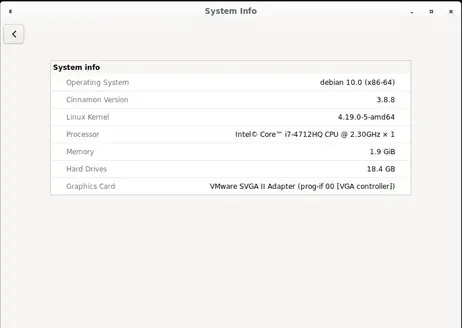Learn how to – Debian 10 (Buster) Released – New Features.
Introduction
Debian 10 was officially released on 06/07/2019. Debian was begun in August 1993 by Ian Murdock, then an undergraduate at Purdue University. It was sponsored by the GNU Project of The Free Software Foundation, the organization started by Richard Stallman and associated with the General Public License (GPL), for one year from November 1994 to November 1995. Since then, it is almost its 26th Anniversary and much has transpired until the impending release of Debian 10 Buster. Much appreciation goes out to all of the people who have made the project grow to such proportions. To all Debian users, the new Buster comes in pomp and even though it is not yet officially released, let us take a moment and check some of the features you might be enjoying soon.

Before we set sail into the new features to expect, the following are the architectures that are supported in Debian 10 Buster:
- 32-bit PC (i386) and 64-bit PC (amd64)
- 64-bit ARM (arm64)
- ARM EABI (armel)
- ARMv7 (EABI hard-float ABI, armhf)
- MIPS (mips (big-endian) and mipsel (little-endian))
- 64-bit little-endian MIPS (mips64el)
- 64-bit little-endian PowerPC (ppc64el)
- IBM System z (s390x)
New Debian 10 (Buster) Features.
Debian 10 comes with several desktop applications and environments. The following are some of the desktop environments GNOME 3.22, KDE Plasma 5.8, LXDE, LXQt 0.11, MATE 1.16, and Xfce 4.12. Buster is the first Debian release to ship with Rust based programs such as Firefox, ripgrep, fd, exa, etc. and a significant number of Rust based libraries (more than 450). Buster ships with Rustc 1.32.
What is more, Wayland is the default session type for GNOME 3.
1. UEFI Secure Boot
With buster, Debian can now be installed and run on most PCs with Secure Boot enabled. Secure Boot is a security feature enabled on most PCs that prevents loading unsigned code, protecting against some kinds of bootkit and rootkits during OS installations.
2. AppArmor enabled per default
Debian Buster for the first time brings a mandatory access control framework enabled per default. New installations of Debian buster will have AppArmor installed and enabled per default. Owing to the large number of security issues being currently experienced around the globe, this is a wonderful move made by Buster. AppArmor is a mandatory access control framework for restricting programs’ capabilities (such as mount, ptrace, and signal permissions, or file read, write, and execute access) by defining per-program profiles.
3. Network filtering based on nftables framework by default
nftables is the new packet classification framework that intends to replaces the existing {ip,ip6,arp,eb}_tables infrastructure. nftables provides a full replacement for iptables, with much better performance, a refreshed syntax, better support for IPv4/IPv6 dual-stack firewalls, full atomic operations for dynamic ruleset updates, a Netlink API for third party applications, faster packet classification through enhanced generic set and map infrastructures, and many other improvements.
4. Cryptsetup defaults to on-disk LUKS2 format
The cryptsetup version shipped with Debian buster uses the new on-disk LUKS2 format. New LUKS volumes will use this format by default.
5. Driverless printing with CUPS 2.2.10
Driverless printing is targeted at the client side of printing and refers to the ability of the client device (computer, smartphone, tablet, laptop etc) to print without having to install any static capability files or drivers (manufacturer-specific or otherwise) on the client. Debian 10 provides CUPS 2.2.10 and cups-filters 1.21.6. Together these give a user everything that is needed to take advantage of driverless printing. The principal requirement is that a network print queue or printer offers an AirPrint service. A modern IPP printer is highly likely to be AirPrint-capable; a Debian CUPS print queue is always AirPrint-enabled.
6. Basic support for Allwinner A64 based devices
Debian buster will have basic suport for many devices based on the Allwinner A64 SoC. THis includes FriendlyARM NanoPi A64; Olimex A64-OLinuXino and TERES-A64; PINE64 PINE A64/A64/A64-LTS, SOPINE, and Pinebook; SINOVOIP Banana Pi BPI-M64; and Xunlong Orange Pi Win(Plus).
7. Linux Kernel 4.19.0-4
Debian Buster will jump from kernel 4.9.0.3 to 4.19.0-4
Installing Debian 10 (Buster)
Installation guide: How To Install Debian 10 Buster – Complete Steps With Screenshots
Conclusion
There are some of the top new features that Buster will come into the field with. There is much more in store as this new release of Debian again comes with a lot more software than its predecessor stretch. This includes over 15346 new packages, for a total of over 51687 packages. Cheers guys.
Also Read:
How to Install LAMP Stack on Debian 10 Buster
Install Docker and Docker Compose on Debian 10 Buster
How to Install PHP on Debian 10 Buster
How To Install Google Chrome Web Browser on Debian
Add Debian 10 Buster official repositories to sources.list
Install Latest Node.js & NPM on Debian
How to Install phpMyAdmin with Apache on Debian 10 (Buster)
Leave a Reply
You must be logged in to post a comment.